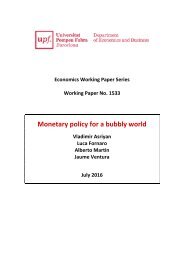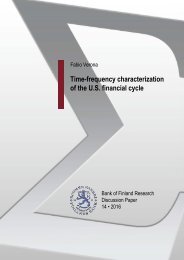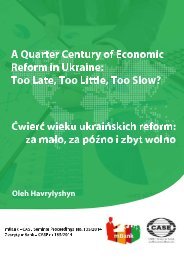Necessity as the mother of invention monetary policy after the crisis
n?u=RePEc:dnb:dnbwpp:525&r=mac
n?u=RePEc:dnb:dnbwpp:525&r=mac
You also want an ePaper? Increase the reach of your titles
YUMPU automatically turns print PDFs into web optimized ePapers that Google loves.
operations <strong>of</strong> <strong>the</strong> Federal Reserve—several <strong>of</strong> which would undermine its independence.<br />
In Europe, support for populist parties that generally do not favour central bank<br />
independence and want to exit EMU and return to national currencies, or even to follow<br />
<strong>the</strong> UK and exit <strong>the</strong> EU, is rising.<br />
We <strong>as</strong>ked our central bankers and economists virtually <strong>the</strong> same question: How much is<br />
your central bank’s independence threatened now or in <strong>the</strong> near-term future? The<br />
answers, tabulated in Table 19, are slightly surprising. On an a priori b<strong>as</strong>is, one might<br />
think that central bank governors would be hyper-sensitive to encroachments on <strong>the</strong>ir<br />
independence. Yet we see far more concern on <strong>the</strong> part <strong>of</strong> academics. About 37% <strong>of</strong> <strong>the</strong>m<br />
believe that CBI is threatened ei<strong>the</strong>r “a lot” or “a moderate amount,” where<strong>as</strong> only 9% <strong>of</strong><br />
central bankers see things that way. At <strong>the</strong> o<strong>the</strong>r end <strong>of</strong> <strong>the</strong> worry spectrum, more than<br />
60% <strong>of</strong> central bankers (50% in advanced economies), but only 13% <strong>of</strong> academics, see no<br />
threat at all. 43<br />
Table 19. Central bank independence in <strong>the</strong> near future<br />
Governors Academics Chi-sq.<br />
All AEs vs. all vs. AEs<br />
CB independence is threatened ______ (N G=55, N A=159) 75.4*** 25.4***<br />
None 61.8 50.0 13.2<br />
A little 10.9 12.5 46.5<br />
A moderate amount 7.3 18.8 27.7<br />
A lot 1.8 0.0 9.4<br />
Too early to judge 18.2 18.8 3.1<br />
Notes: Percentages <strong>of</strong> number <strong>of</strong> responding governors or academics. *** denotes significance at<br />
<strong>the</strong> 1% level, calculated using Chi-squared tests for <strong>the</strong> independence <strong>of</strong> responses <strong>of</strong> governors and<br />
academics. NG/NA denotes number <strong>of</strong> responding governors/academics. Source: Authors’<br />
calculations b<strong>as</strong>ed on survey among central bank governors conducted in 2016.<br />
Can we say more about <strong>the</strong> determinants <strong>of</strong> p<strong>as</strong>t or expected changes to independence?<br />
Table 20 reports <strong>the</strong> marginal effects for <strong>the</strong> lowest category <strong>of</strong> our dependent variable<br />
(i.e. central bank independence w<strong>as</strong> “gained” during <strong>the</strong> <strong>crisis</strong>; independence is “not”<br />
threatened) from an ordered probit model. One interesting question is whe<strong>the</strong>r <strong>the</strong> amount<br />
<strong>of</strong> criticism that <strong>the</strong> central bank h<strong>as</strong> received h<strong>as</strong> a bearing on threats to its independence.<br />
For parsimony, we transform <strong>the</strong> corresponding variable into a dummy variable equal to<br />
one when <strong>the</strong> governor h<strong>as</strong> responded that <strong>the</strong> central bank h<strong>as</strong> received “a lot” <strong>of</strong><br />
criticism.<br />
Hardly any <strong>of</strong> our variables help explain p<strong>as</strong>t changes in independence; having adopted<br />
QE using o<strong>the</strong>r <strong>as</strong>sets is <strong>the</strong> only one that h<strong>as</strong> some impact. In contr<strong>as</strong>t, looking forward,<br />
we have strong evidence that <strong>the</strong> likelihood that a governor sees no threat to independence<br />
is considerably smaller in countries where <strong>the</strong>re w<strong>as</strong> a discussion outside <strong>the</strong> central bank<br />
43<br />
We remind readers, once again, that a majority <strong>of</strong> our academics come from <strong>the</strong> geographical are<strong>as</strong> <strong>of</strong> only three central banks:<br />
The Fed, <strong>the</strong> ECB, and <strong>the</strong> Bank <strong>of</strong> England.<br />
39








